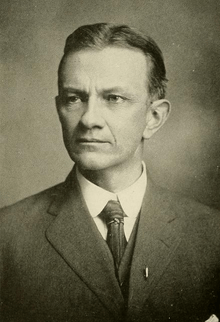Kenyon L. Butterfield
| Kenyon Leech Butterfield | |
|---|---|
 | |
| Kenyon L. Butterfield c. 1922 | |
| President of the Rhode Island College of Agriculture and the Mechanic Arts, (now the University of Rhode Island) | |
| In office 1903–1906 | |
| President of the Massachusetts Agricultural College (now the University of Massachusetts Amherst) | |
| In office 1906–1924 | |
| President of Michigan Agricultural College, (now Michigan State University) | |
| In office 1924–1928 | |
| Personal details | |
| Born | June 11, 1868 Lapeer, Michigan |
| Died | November 25, 1936 (aged 68) Amherst, Massachusetts |
| Signature | |
Kenyon Leech Butterfield (June 11, 1868 – November 25, 1936) was an American agricultural scientist and college administrator known for developing the Cooperative Extension Service at the Land Grant Universities. He was president of the Rhode Island College of Agriculture and Mechanic Arts (1903-1906); the Massachusetts Agricultural College (1906-1924), and the Michigan Agricultural College, (later Michigan State College of Agriculture and Applied Science, which is now Michigan State University) from 1924 to 1928.
Butterfield was an early proponent of extension education programming at the Land Grant Colleges rather than extension activities being a direct responsibility of the U.S Department of Agriculture, an idea championed by Extension pioneer Seaman A. Knapp.[1] Using state funds in April 1904, Butterfield created an Agricultural Extension Department at the Rhode Island College of Agriculture and Mechanic Arts, and later in 1906, he did the same at Massachusetts Agricultural College. The organizational structure of these two colleges formed the basis for developing the Smith-Lever Act of 1914 that authorized federal funding of comprehensive Cooperative Extension programming by Land Grant Colleges and Universities nationwide.[2]
Butterfield Hall at the University of Rhode Island, Butterfield House at the University of Massachusetts Amherst and Butterfield Hall of the Brody Complex at Michigan State University are all dedicated in his name.
Selected works
- "The Social Phase of Agricultural Education", Popular Science Monthly (1905)
- Inaugural Address, Massachusetts Agricultural College (1906)
- "Federation of Rural Social Forces", The Making of America Vol. V (1907)
- Dedication Address of the Petersham Agricultural High School (1908)
- "Chapters in Rural Progress" (1908)
- "Rural Life and the Family", Proceedings of the third annual meeting of the American Sociological Society (1908)
- "The Country and the Rural Problem" (1909)
- "The Call of the Country Parish" (1914)
- "A State System of Agricultural Education" (1916)
- "The Farmer and the New Day" (1919)
- "Education and Chinese Agriculture" (1922)
- "The Christian Mission in Rural India" (1930)
- "The Training of Missionaries for Rural Service" (1933)
References
- ↑ Butterfield, K.L. (1901). "VII. Discussions: A Significant Factor in Agricultural Education." Educational Review 21:301-306 (March, 1901).
- ↑ Rice, M.A., S. Rodrigues and K. Venturini. "Philosophical & Institutional Innovations of Kenyon Leech Butterfield and the Rhode Island Contributions to the Development of Land Grant and Sea Grant Extension". Century Beyond the Campus: Past, Present, and Future of Extension A Research Symposium to Mark the 100th Anniversary of the Smith-Lever Act September 24 – 25, 2014, West Virginia University. Waterfront Place Hotel, Morgantown, West Virginia, USA. Sep. 2014. Retrieved 23 Dec 2014.
External links
![]() Media related to Kenyon L. Butterfield at Wikimedia Commons
Media related to Kenyon L. Butterfield at Wikimedia Commons
- Biographical Information (Michigan State University Archives & Historical Collections)
- University of Rhode Island Historical Timeline
- Works by Kenyon L. Butterfield at Project Gutenberg
- Works by or about Kenyon L. Butterfield at Internet Archive
| Academic offices | ||
|---|---|---|
| Preceded by David Friday |
President of Michigan Agricultural College 1924–1925 |
Succeeded by Himself |
| Preceded by Himself |
President of Michigan State College of Agriculture and Applied Science 1925–1928 |
Succeeded by Robert S. Shaw |
| ||||||
| ||||||||||
|